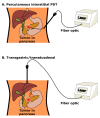Photodynamic Therapy for Pancreatic Ductal Adenocarcinoma
- PMID: 34503165
- PMCID: PMC8431269
- DOI: 10.3390/cancers13174354
Photodynamic Therapy for Pancreatic Ductal Adenocarcinoma
Abstract
Pancreatic ductal adenocarcinoma (PDAC) is among the most lethal of human cancers. Clinical trials of various chemotherapy, radiotherapy, targeted agents and combination strategies have generally failed to provide meaningful improvement in survival for patients with unresectable disease. Photodynamic therapy (PDT) is a photochemistry-based approach that enables selective cell killing using tumor-localizing agents activated by visible or near-infrared light. In recent years, clinical studies have demonstrated the technical feasibility of PDT for patients with locally advanced PDAC while a growing body of preclinical literature has shown that PDT can overcome drug resistance and target problematic and aggressive disease. Emerging evidence also suggests the ability of PDT to target PDAC stroma, which is known to act as both a barrier to drug delivery and a tumor-promoting signaling partner. Here, we review the literature which indicates an emergent role of PDT in clinical management of PDAC, including the potential for combination with other targeted agents and RNA medicine.
Keywords: combination therapy; drug delivery; pancreatic cancer; pancreatic ductal adenocarcinoma (PDAC); photodynamic therapy (PDT); photomedicine; stroma.
Conflict of interest statement
The authors declare no conflict of interest.
Figures




References
Publication types
Grants and funding
LinkOut - more resources
Full Text Sources

